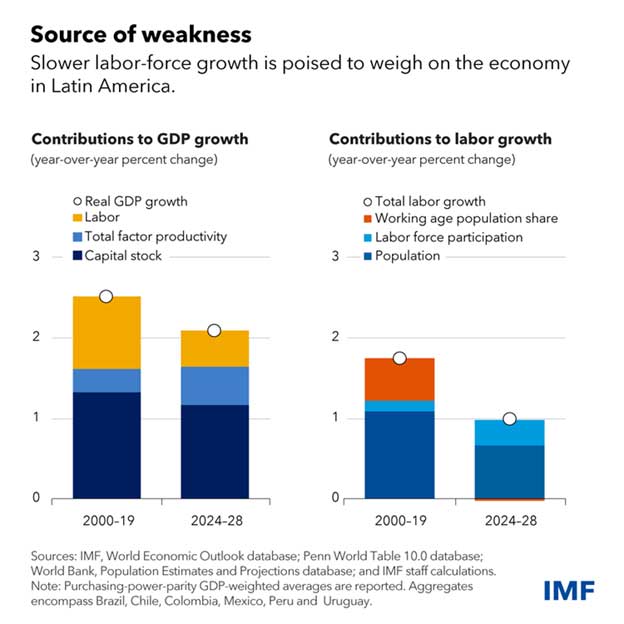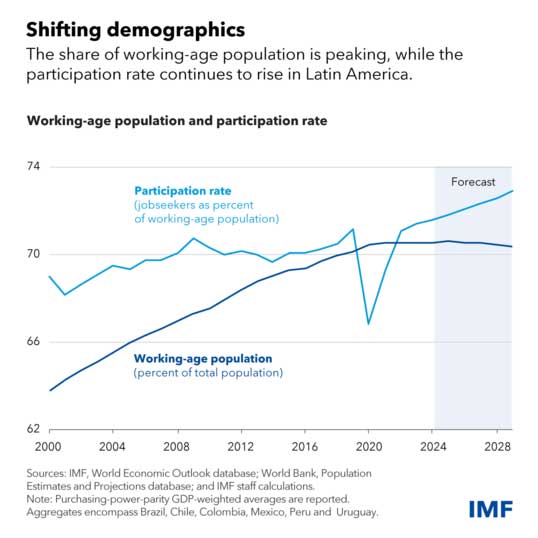ARTICLE AD
 Opinion by Gustavo Adler, Rodrigo Valdes_2 (washington dc)Monday, April 29, 2024Inter Press Service
Opinion by Gustavo Adler, Rodrigo Valdes_2 (washington dc)Monday, April 29, 2024Inter Press ServiceWASHINGTON DC, Apr 29 (IPS) - Latin America’s workforce grew by nearly 50 percent in the two decades before the pandemic, helping boost economic growth. Now demographic trends are turning, and likely to weigh on growth in the coming years.
We expect growth in Latin America to average about 2 percent per year in the next five years, below its already low historical average. These projections are also considerably weaker than those for other emerging market economies across Europe and Asia, which are also expected to slow but still grow by 3 percent and 6 percent annually, respectively.
This weaker outlook party reflects long-standing challenges of low investment and slow productivity growth. The additional challenge this time is that the demographics are turning, and the labor force won’t grow as fast as before.
Turning Demographics
Population growth will continue decelerating, falling from about 1 percent per year in the two decades preceding the pandemic to about 0.6 annually in the next five years. This is not necessarily bad news as a growing population does not automatically mean rising income per capita—the most relevant measure of wellbeing.
Although a larger population means a larger labor force and aggregate output, it also means a larger number of people among whom output is shared. Still, growing the economy through a larger population can help in other ways, including by increasing revenues to repay high debt levels.

More importantly, the demographic dividend is fading as the region’s population is aging and the share of the working-age population is peaking. This means that the share of the population able to generate income will stop growing. It is an important change as this share had been growing until now, enabling the labor force to grow 0.5 percent per year since 2000. In contrast, we expect no growth in the share of working-age population over the next five years, on average.
Boosting participation
Keeping the labor force engine running will require boosting labor force participation. And some of this is expected to happen, as the share of working-age jobseekers is projected to continue rising.
But for this to become a reality, it will be key to further integrate women into the labor force. Their participation remains low, at only 52 percent of working-age women compared to 75 percent of men.

Policies can help. Expanding childcare programs and providing more training for women can help raise female participation, as we have discussed in recent country reports, including for Brazil and Mexico.
Ensuring that household taxation does not discourage secondary household earners and eliminating asymmetric childcare and parental leave benefits between men and women, that ultimately discourage hiring of women or affect their pay, can also help bring more women into the labor force.
Countries can also grow their workforce by providing vocational training opportunities, raising the retirement age, eliminating disincentives for work after retirement and adopting policies that facilitate employment of older workers.
Tackling crime—an important factor behind migrant outflows in some parts of the region—should also be on the agenda.
But also, as demographics become less favorable, countries will need to put more effort into raising labor productivity growth, by tackling poor governance, stringent business regulations, and widespread informal work (which constrains firms’ growth and the associated productivity gains).
This will help raise living standards even amid demographic headwinds.
Latin America’s many years of hard work to strengthen macroeconomic frameworks has paid off. Countries successfully navigated the last two large global economic recessions and avoided a painful repeat of past crises.
Now they must take advantage of this resilience to focus on boosting potential growth, a persistent challenge that’s mounting as demographic fortunes turn.
Source: International Monetary Fund (IMF)
IPS UN Bureau
Follow @IPSNewsUNBureau
Follow IPS News UN Bureau on Instagram
© Inter Press Service (2024) — All Rights ReservedOriginal source: Inter Press Service

 8 months ago
40
8 months ago
40 